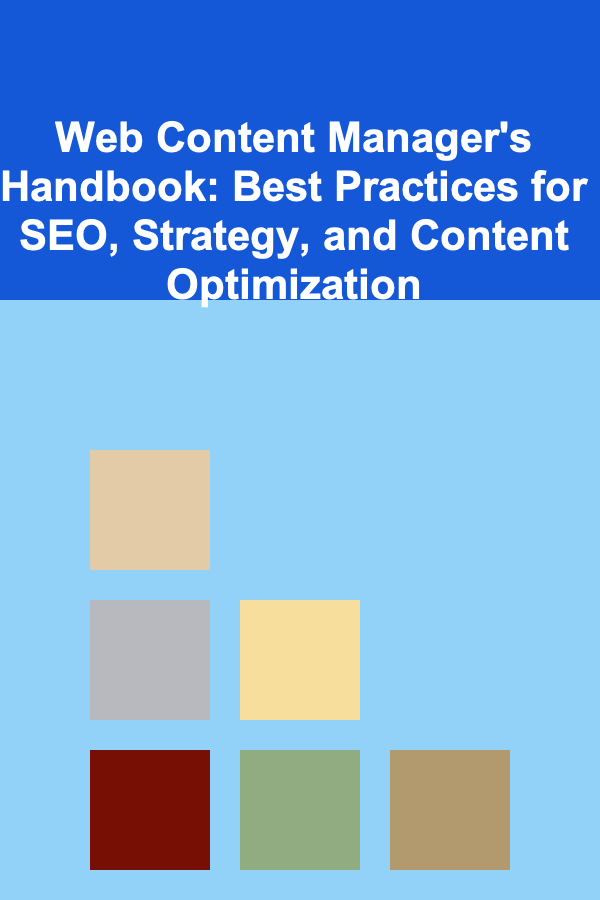
How to Integrate Content Marketing with Your Dropshipping Store's Sales Funnel
ebook include PDF & Audio bundle (Micro Guide)
$12.99$7.99
Limited Time Offer! Order within the next:

Content marketing is one of the most effective tools for driving traffic, building relationships, and increasing conversions for any online business, including dropshipping stores. However, integrating content marketing with your sales funnel is a step that many entrepreneurs overlook, missing out on significant opportunities to convert visitors into paying customers. In this comprehensive guide, we will explore how to integrate content marketing with your dropshipping store's sales funnel, covering each phase of the funnel from awareness to conversion.
Understanding the Sales Funnel in Dropshipping
Before diving into how content marketing fits into the sales funnel, it's essential to understand the structure of a typical sales funnel. A sales funnel represents the journey that a potential customer takes from first becoming aware of your store to making a purchase. For dropshipping stores, the funnel can typically be broken down into four key stages:
- Awareness: This is the top of the funnel (TOFU), where potential customers first become aware of your brand, products, and services.
- Interest: In this stage, prospects are engaged by your content and are interested in learning more about what you offer.
- Decision: Here, prospects evaluate your store against competitors, weigh the benefits, and consider making a purchase.
- Action: This is the bottom of the funnel (BOFU), where a customer takes action, such as making a purchase.
The Role of Content Marketing at Each Funnel Stage
Now that we have an understanding of the funnel stages, let's break down how content marketing fits into each phase of the funnel.
1. Awareness Stage: Attracting Your Audience
The awareness stage is where content marketing begins to play a crucial role in attracting potential customers to your dropshipping store. At this point, prospects are unaware of your brand, and your goal is to reach them and make them aware of what you offer.
Content Strategies for the Awareness Stage:
- Blog Posts: Create informative and valuable blog posts around topics related to your products or niche. For example, if you sell fitness products, you could write blog posts about workout tips, healthy habits, or how to use specific fitness equipment.
- SEO (Search Engine Optimization): Optimize your blog posts and landing pages for search engines. Conduct keyword research to identify high-traffic, low-competition keywords related to your products and industry. Use these keywords to rank higher in search results and attract organic traffic.
- Social Media Content: Use platforms like Instagram, Facebook, TikTok, or YouTube to share valuable content, such as tutorials, tips, and behind-the-scenes footage. For instance, share how-to guides on using your products or user-generated content that features your products in real life.
- Guest Blogging & Influencer Collaborations: Guest blog on industry-related websites or collaborate with influencers in your niche to increase brand awareness. These partnerships expose your store to a broader audience and can drive traffic to your website.
By providing value through content, you build trust and establish your store as an authority in your niche, which helps you attract the right audience at the awareness stage.
2. Interest Stage: Engaging and Nurturing Leads
Once a potential customer is aware of your store, the next step is to nurture their interest. In this stage, the goal is to keep prospects engaged and convince them that your products can solve their problems or fulfill their needs.
Content Strategies for the Interest Stage:
- Email Marketing: Offer a lead magnet, such as an eBook, checklist, or discount, in exchange for their email address. Once you have their email, send them valuable content, such as product recommendations, blog posts, and educational resources. Personalize your emails to increase engagement and build a relationship.
- Video Tutorials: Create engaging video content that explains how your products work or how they can improve the customer's life. For example, if you're selling kitchen gadgets, make videos showing how to use them to prepare meals quickly and efficiently.
- Product Guides & Reviews: Create comprehensive product guides that highlight the features, benefits, and uses of your products. Including customer reviews or testimonials in your content can increase trust and provide social proof that encourages interest.
- Webinars or Live Streams: Hosting webinars or live streams where you demonstrate your products in action can be a powerful way to engage your audience. During these sessions, you can answer questions, address objections, and provide exclusive offers to viewers.
The goal in the interest stage is to create content that builds a relationship with your audience and fosters a deeper connection with your products.
3. Decision Stage: Convincing Prospects to Choose Your Store
The decision stage is where prospects are actively evaluating your products and deciding whether or not to make a purchase. This is the critical phase where content marketing can make the difference between someone becoming a customer or leaving your site without buying.
Content Strategies for the Decision Stage:
- Case Studies & Success Stories: Create detailed case studies that demonstrate how your products have solved problems or improved the lives of your customers. Real-world examples can help prospects see the value of your products.
- Comparison Charts: Many customers in the decision stage are comparing your products to competitors. Create comparison charts that highlight the benefits and unique selling points (USPs) of your products over the competition.
- Discounts & Limited-Time Offers: Content marketing can also be used to promote special deals, discounts, or time-limited offers. A blog post or email highlighting a limited-time discount can create a sense of urgency and push prospects toward making a decision.
- Customer Testimonials: Display customer testimonials prominently on your website and in your content. Social proof is one of the most effective ways to persuade prospects to make a purchase. Video testimonials or reviews are especially powerful, as they add authenticity and credibility.
At this stage, your content should reassure prospects that your store is the best choice and guide them toward making a decision.
4. Action Stage: Converting Prospects into Paying Customers
The action stage is the final step in the funnel, where you turn leads into paying customers. Content marketing here is all about providing the final push to convert your prospects into buyers.
Content Strategies for the Action Stage:
- Clear Call-to-Actions (CTAs): Ensure your content includes clear, compelling CTAs that lead customers to the checkout process. For example, a blog post might end with a CTA inviting readers to "Shop Now" and get an exclusive offer.
- Retargeting Ads: Use retargeting ads to remind visitors who have abandoned their carts or browsed your products without purchasing. These ads can showcase your products, offer discounts, or highlight new arrivals to encourage conversions.
- Urgency & Scarcity Tactics: Leverage content that highlights scarcity or urgency to prompt immediate action. Phrases like "only 3 left in stock" or "sale ends in 24 hours" can push hesitant prospects to make a purchase.
- Follow-Up Emails: If a prospect adds a product to their cart but doesn't complete the purchase, send follow-up emails to remind them about the items they left behind. Include an incentive like a discount or free shipping to encourage them to finalize the sale.
In the action stage, your content should eliminate any remaining doubts and make the purchase process as easy and compelling as possible.
Integrating Content Marketing with Your Sales Funnel
To successfully integrate content marketing with your dropshipping store's sales funnel, it's essential to ensure that your content is aligned with the needs and expectations of your audience at each stage of the funnel. Here are some tips for integrating content marketing effectively:
- Personalization: Personalize your content based on customer behavior and preferences. Use data analytics to understand which content resonates most with different segments of your audience.
- Consistency: Consistently produce high-quality content that is relevant to your audience. Make sure that your messaging remains consistent across all content platforms and aligns with your brand identity.
- Cross-Channel Marketing: Don't limit your content marketing to one channel. Leverage multiple channels like social media, email marketing, and your website to deliver a unified and omnipresent message.
- Measure and Optimize: Continuously track the performance of your content across each stage of the funnel. Use analytics tools to monitor website traffic, conversion rates, and email engagement. Adjust your content strategy based on these insights to improve your funnel performance.
Conclusion
Integrating content marketing with your dropshipping store's sales funnel is a powerful way to attract, engage, and convert customers. By creating valuable content that aligns with each stage of the funnel, you guide prospects from awareness to action while building trust and providing real value. Whether it's blog posts, videos, email marketing, or social media content, each piece of content plays a crucial role in nurturing leads and increasing conversions. With consistent effort and the right content strategies, you can create a seamless, effective sales funnel that drives growth for your dropshipping business.

How to Find the Best Coupon Codes for Maximum Savings
Read More
Mastering Web Content Management: Strategies and Tactics for a Successful Career as a Web Content Manager
Read More
Web Content Manager's Handbook: Best Practices for SEO, Strategy, and Content Optimization
Read More
How To Embrace Change and Adapt to New Situations
Read More
How to Make Healthy Salad Dressings for Weight Loss
Read More
How to Create a Healthy Habits Planner for Plant-Based Eating
Read MoreOther Products

How to Find the Best Coupon Codes for Maximum Savings
Read More
Mastering Web Content Management: Strategies and Tactics for a Successful Career as a Web Content Manager
Read More
Web Content Manager's Handbook: Best Practices for SEO, Strategy, and Content Optimization
Read More
How To Embrace Change and Adapt to New Situations
Read More
How to Make Healthy Salad Dressings for Weight Loss
Read More